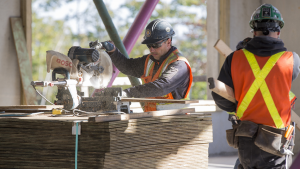Canada’s Building Trades Unions (CBTU) has launched a national program called Building it Green that aims to upskill construction tradespeople in climate-friendly and sustainable practices.
The program consists of a free, 2.5-hour online foundation course for unionized building trades apprentices and journeypersons as well as affiliated unions and contractor-employer partners.
The goal is to strengthen their ability to manage the pressing needs of climate change and help them understand how it and sustainability can intersect with construction.
A single-day, train-the-trainer, in-person workshop has also been developed to teach instructors how to integrate the lessons into their existing curriculum.
The courses will be available in more than 200 union training centres across the country. Mainland Building Trades Council in Nova Scotia was the first to roll out the curriculum earlier this year.
“The tradespeople are leading this transition in the construction industry and we want to make sure that tradespeople are well equipped with the knowledge and they know that construction is not necessarily a barrier, but it’s a solution,” explains Lindsay Amundsen, director of workforce development at the building trades. “We want them to understand the ‘why’ and be more engaged in understanding their role and how different trades can work together.
“It’s just providing that foundational knowledge and then, of course, we want to continue this training and ensure that no one is left behind as some of our trades transition or there’s new skills upgrading. We want to make sure there’s a place for our tradespeople and they’re not left behind.”
In addition to the building trades, other workforce development organizations collaborated on the project, including SkillPlan, the Climate Industry Research Team, and Social Research and Demonstration Corporation. It was funded through the Canadian Apprenticeship Strategy’s Union Training and Innovation Program.
Training focuses on green building for present and future
The trades training portion of the course is self-directed and consists of interactive modules that use videos, activities, quizzes and workplace scenarios that are contextualized for the building trades.
The training focuses on green building practices and contains the basics that apprentices and journeypersons need to know to deliver high-performance projects today and in the future. The material was developed by training instructors and directors in various trades across Canada.
The train-the-trainer workshop will empower trainers to integrate climate literacy into apprenticeship training for net-zero construction, increase green building awareness and share effective teaching strategies.
Trainers will have access to a library of resources, including trade-specific learning modules to support their in-class delivery, presentation slides, trainer notes and suggested in-class activities.
The program continues the learning journey by providing on-the-job support that includes toolbox talks and aids and promotional material for a jobsite that is housed in a digital repository.
“We are making sure that we update this information as things change and evolve over time in the trades,” says Amundsen. “We’re going to update our content so that it is always fresh. We see this as sort of step one and building that foundation and knowledge and, as there are new job opportunities out there, we can work together to complement that training and build off of it.”
Industry keen to engage in the project
The idea for the program originated in 2021.
The building trades worked with climate academics to get a handle on what training is available, examine what’s being done elsewhere, and figure out gaps. As part of their research, they looked at programs in the U.S., Europe and Australia.
An analysis was done to figure out what apprentices, journeypersons and instructors know about climate change, what they believe is construction’s role, and how the trades can work together.

The team interviewed trades and instructors and learned they were already being taught some of the necessary skills but didn’t explicitly know that they had a bearing on climate change.
“They were just being taught a skill but they weren’t linking it to the ‘why’ so that was interesting,” says Amundsen.
Generally speaking, the academics found some instructors didn’t feel well-equipped to speak on the topic in the classroom, she says, and were either a bit nervous or didn’t feel prepared and needed some education themselves, so the program was adapted to also support the instructors.
The program was officially announced recently at the International Brotherhood of Electrical Workers 586 training centre in Ottawa by CBTU executive director Sean Strickland. Employment, Workforce Development and Official Languages Minister Randy Boissonnault attended the event.
The building trades decided to roll out the program now because Canada is moving to achieve net-zero by 2050. Research has also identified that buildings and construction are among the three primary sources of greenhouse gas emissions and, as a result, the industry has been tapped to identify methods that can be implemented to achieve higher climate standards.
“It’s really looking at the big picture overall and linking it back to the jobs that they do and the impact that they have right down to the jobsite,” said Amundsen.
“It’s been fun to work on this. I’ve been happy with the engagement that we’ve been receiving, particularly from the instructors and the advisory committee on our project. They’ve been really, really engaged in championing this. So, that means a lot.”






Recent Comments